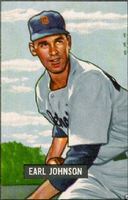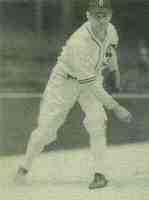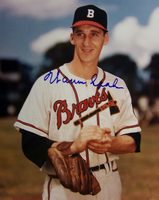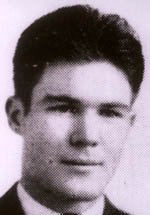

Baseball and the Battle of the Bulge
by Gary Bedingfield
Thinking the Ardennes was
the least likely spot for a German offensive, American Staff
Commanders chose to keep the line thin, so that the manpower might
concentrate on offensives north and south of the Ardennes.
The American line was
held by three divisions and a part of a fourth, while a fifth was
making a local attack and a sixth was in reserve. Division sectors
were more than double the width of normal, defensive fronts.
Even though the German
offensive achieved total surprise, nowhere did the American troops
give ground without a fight.
Although two of the 106th
Division’s three regiments were forced to surrender.Within
three days, the determined American stand and the arrival of
powerful reinforcements insured that the ambitious German goal was
beyond reach.
In snow and sub-freezing
temperatures the Germans failed to meet their objective - that of
reaching the sprawling Meuse River on the edge of the Ardennes. All
that they accomplished was to create a Bulge in the American line -
hence the name “The Battle of the Bulge”. The Germans lost
irreplaceable men, tanks and equipment. On January 25, 1945, after
heavy losses on both the American and German sides, the Bulge ceased
to exist. The Battle
of the Bulge was the most bloody of the battles American
forces experienced in Euorope in WWII, with
81,000 casualties, including 23,554
captured and 19,000 killed.
Baseball
in Wartime
remembers the players who were at the Battle of the Bulge.
Andy
Anderson
Majors
1948-1949
Anderson
was captured by the Germans during the Battle of the Bulge and
suffered a debilitating case of frostbite. His weight dropped from
185 pounds to 125 pounds while in a POW camp. After returning to the
US he was sent by the army to Santa Barbara (CA) to recuperate and
gain his strength.
Despite
the frostbite limiting his range, Anderson resumed his baseball
career in 1946 with San Antonio (Texas League). He appeared in 51
games with the Browns in 1948 and batted a respectable .276. The
following season, however, he could manage only a .125 average over
71 games which brought an end to his major league career.
Read Andy Anderson's
complete biography
Richard
Catalano
Minors
1941
Catalano,
an outfielder, played in the Penn State Association in 1941. He also
played in the All-Professional
game against the Army Air Force in London, England in 1943.
Catalano
saw action in France and at the Battle of the Bulge in 1944 and
1945. He was invited to spring training by the St Louis Cardinals in
1946 but declined the offer. He never returned to professional
baseball.
Buck
Compton
UCLA
1939-1942
Lieutenant Compton was with the 506th
Parachute Infantry Regiment of the 101st Airborne
Division during the stand at Bastogne. Weather conditions were
atrocious and, in the heavy snow, Compton suffered a severe case of
trenchfoot. He was evacuated and his combat days were over.
Read Buck Compton's complete biography
Murry
Dickson
Majors
1939-1959
When the
war ended, he traded fatigues for flannels and pitched the 35th
Infantry Indians to a series of victories in exhibitions games in
Germany and France.
Dickson
was back with the Cardinals in 1946 and remained in the major
leagues until 1959.
Read Murry Dickson's complete biography
Bill
Hansen
Minors
1941-1942
Bill Hansen signed with Greenville in 1941. He was with the Green
Bay Blue Jays of the Wisconsin State League in 1942 and his contract
was purchased by the Milwaukee Brewers of the American Association
at the end of season, but military service beckoned before he had
the opportunity to report.
Sergeant Hansen served with the US Army in the Battle of the Bulge.
He died from wounds received in combat in January 1945.
Victor
Hartline
Pre-War
Semi-Pro in Michigan
Victor Hartline attended
New Troy High School and Western Michigan College.
The talented young ballplayer became
well-known in Niles, Michigan and played for Studebaker and the
Knights of Pythias in South Bend. Hartline was due for a tryout with
the Chicago Cubs when military service beckoned.
In 1944, he left behind
his wife, Evelyn, and their young son, Ronald Lee, for service with
the Army in Europe. On January 21, 1945, four days before the Battle
of the Bulge ended, Sergeant Hartline was killed in action.
Read Victor Hartline's complete biography
Ernie
Holbrook
Minors
1936
Ernie Holbrook was a star
athlete at the University of Southern California. He signed a
professional contract with Charlotte in 1936, and also played for
Rocky Mount and Canton that year. In 1937 he was with Clarksdale and
Mansfield.
The following year he
returned to California to coach high school baseball teams. In 1943
he joined the coaching staff of USC and guided their basketball team
to a 31-17 record.
Holbrook was in military
service shortly afterwards and served with the 28th Infantry
Division in Europe. Private Holbrook was reported missing in action
in January 1945. It was later confirmed he had died in combat in
Belgium on December 16, 1944 – the first day of the Battle of the
Bulge.
USC still has The Ernie
Holbrook Memorial Award, given annually to the team's most
inspirational basketball player.
Ralph
Houk
Majors
1947-1954
Read Ralph Houk's complete biography
Ernie
Hrovatic
Minors
1942-1943
Private First Class
Hrovatic was assigned to the 3rd
Armored Division and was sent overseas to Europe in June 1944. He
was killed in action in Belgium,
on January 14, 1945, during the final days of the Battle of the
Bulge.
Earl
Johnson
Majors
1940-1951
The
promising southpaw enlisted in the Army immediately after Pearl
Harbor and served in the European Theater with the 30th Infantry
Division. He was awarded the Silver Star and Bronze Star and was
commissioned a lieutenant on the field for extraordinary valor
during the Battle of the Bulge.
Johnson
won the opening game of the 1946 World Series for the Red Sox and
continued to pitch in the major leagues until 1951.
Read Earl Johnson's
complete biography
Jack
Knott
Majors
1933-1946
He
returned from three years of military service to pitch just three
games for the Athletics in 1946.
Clarence
Maddern
Majors
1946-1951
Maddern
played ball with the 76th Division team at the end of the
war and returned to professional baseball with Tulsa in 1946, making
three major league appearances with the Cubs. His last season in the
majors was in 1951.
Ralph
McLeod
Majors
1938
Ralph
McLeod played six games for the Boston Braves in 1938. He served
with the 75th Infantry Division during WWII and was shipped to
Europe in 1944. McLeod’s division went into action on Christmas Eve
during the Battle of the Bulge.
After the
war ended in Europe, McLeod played baseball all over Europe. After
missing four seasons in military service, he could see no point in
returning to baseball and worked as a firefighter with the Quincy
(Massachusetts) Fire Department.
Read Ralph McLeod's
complete biography
Hank
Nowak
Minors
1938-1941
Military service beckoned on March 2, 1942 and he was assigned to
the US Army's special service section of the Quartermaster
Replacement Training Center at Camp Lee, Virginia. In October 1944,
Sergeant Nowak arrived in Europe ready for combat duty. Nowak was
killed in action on New Year's Day 1945. He was 26 years old.
Steve
Souchock
Majors
1946-1955
During an
eight-season major league career following the war, Souchock was
with the Yankees, White Sox and Tigers. In 1953, he batted .302 in
89 games with 46 RBIs and 11 home runs.
Read Steve
Souchock's complete biogarphy
Warren
Spahn
Majors
1942-1965
The 276th
soon found themselves in the Battle of the Bulge. "We were
surrounded in the Hertgen Forrest and had to fight our way out of
there,” recalled Spahn. “Our feet were frozen when we went to sleep
and they were frozen when we woke up. We didn't have a bath or
change of clothes for weeks."
With the war over, Spahn returned to Boston in 1946 and posted an
8-5 record and solid 2.94 ERA in 24 appearances. In 1947 he had the
first of thirteen 20-win seasons.
Spahn pitched his last game in the majors for the San Francisco
Giants in 1965, aged 44.
Read Warren Spahn's complete biography
Hank Thompson
Majors
1947-1956
Thompson entered military service in March 1944. He served with the
1695th Combat Engineers. In late 1944, the 1695th were
sent to Europe and Thompson manned a machine gun during the Battle
of the Bulge.
He
joined the St Louis Browns in 1947 and stayed in the major leagues
until 1956.
Read Hank Thompson's complete biography
Jocko
Thompson
Majors
1948-1951
He
reached the majors with the Phillies in 1948. In 1951 he was 4-8 in
29 games with a 3.85 ERA.
Read Jocko Thompson's complete biography
Cecil
Travis
Majors
1933-1947
During
the Battle of the Bulge, much of his time was spent in a frozen
foxhole and Travis suffered severe frostbite. Military doctors
worked hard to save his feet. In September 1945, upon his return to
the Senators, the Washington Evening Star reported, "It was
amazing the way Cece swung in his drill at Griffith Stadium
yesterday...his easy left-hand stance at the plate was no different
from that he assumed when he was one of the sensations of the
American League in offense." But things were different, Travis, who
went to war aged 28 was now 32, but more significantly, the effects
of harsh winter conditions in Europe had taken its toll on his legs.
He never regained his pre-war abilities and after two poor seasons
he retired.
My problem when I got back to baseball was my timing," said Travis,
"I could never seem to get it back the way it was after laying out
so long. I saw I wasn't helping the ball club, so I just gave it
up."
Read Cecil Travis' complete biography
Ken
Trinkle
Majors
1943-1949
A relief
specialist he led the National League in appearances in 1946 and
1947.
Read Ken Trinkle's complete biography
Elmer
Wachtler
Minors 1942-1943
In the fall of 1944, Staff Sergeant
Elmer Wachtler left his young wife and two year old son, Jimmy, and
sailed to Europe where he soon entered combat as a replacement with
the 134th Infantry Regiment, 35th Infantry Division.
On January 5,
1945, during the breakout at Bastogne in snow and freezing
temperatures, 26-year-old Elmer Wachtler was killed in action.
Initially, his wife, Mary, was notified by the War Department that
Elmer was missing, but his death was confirmed in April 1945.
Eugene
Westover
College
He
served with the Army in Europe and was killed in action on January
1, 1945 in the Battle of the Bulge.
Ernie White
Majors
1940-1948
Before
the war in 1941, White had enjoyed an outstanding rookie season with
the Cardinals, going 17-7 with a 2.40 ERA. In the 1942 World Series,
he was the first pitcher since 1926 to shut out the Yankees in a
post-season game, winning the third game. He was never able to
regain that form after returning from the war.
Dick
Whitman
Majors
1946-1951
In 1946,
he played 104 games with Brooklyn and batted .260. despite the fact
that his only previous professional experience consisted of less
than one full season in Class B and C. Whitman played in the majors
until 1951, and led the National League in pinch hits in 1950, going
12-for-39 and helping the Phillies to the pennant.
Hoyt
Wilhelm
Majors
1952-1972
He was 28
when the Giants decided to try him in their bullpen in 1952. He
twice led the NL in games pitched and was a four-time all-star. He
was inducted in the Hall of Fame in 1985. If you like this website you may consider making a donation

After the war in Europe ended Compton played baseball with the Seine
Base Clowns in Paris, France.
Back home in California in 1946, Compton turned down an offer to
play minor league baseball and spent five years as a detective in
the Los Angeles Police Department. In 1952 he began 20 years as a
prosecutor for the district attorney's office. In 1968, he was
responsible for the investigation of Robert F Kennedy's assassin,
Sirhan Sirhan. He was later appointed an associate judge in the
California Court of Appeals.
 Ralph
Houk had played two seasons in the Yankees' organization before
joining the Army. Serving with the 9th Armored Division, Houk
saw combat in France and at the Battle of the Bulge. On one
occasion, he took a bullet through the helmet but was not
seriously wounded.
Ralph
Houk had played two seasons in the Yankees' organization before
joining the Army. Serving with the 9th Armored Division, Houk
saw combat in France and at the Battle of the Bulge. On one
occasion, he took a bullet through the helmet but was not
seriously wounded.
Houk left the Army with the rank of major and joined the Yankees
as a back-up catcher in 1947. His
leadership skill acquired in his military service landed him the
coveted
job of Yankees manager in 1961, and he led the team to two
World Series championships. Houk continued to manage in the
majors until 1984.





Spahn later received a battlefield commission for his part in
maintaining the traffic flow across the Ludendorf Bridge at Remagen

Thompson was discharged from the Army in June 1946. He rejoined the
Monarchs and helped them to the Negro League World Series where they
were beaten by the Newark Eagles.

 Trinkle was with the 9th Armored Division during their involvement
in the Battle of the Bulge, and was awarded the Bronze Star.
Trinkle was with the 9th Armored Division during their involvement
in the Battle of the Bulge, and was awarded the Bronze Star. 


